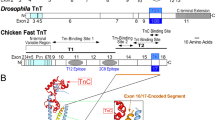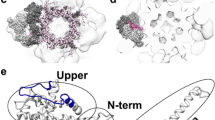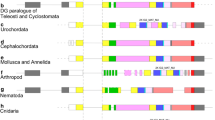Abstract
The muscle-myosin heavy-chain (mMHC) gene of Drosophila hydei has been sequenced completely (size 23.3 kb). The sequence comparison with the D. melanogaster mMHC gene revealed that the exonintron pattern is identical. The protein coding regions show a high degree of conservation (97%). The alternatively spliced exons (3a-b, 7a-d, 9a-c, 11a-e, and 15a-b) display more variations in the number of nonsynonymous and synonymous substitutions than the common exons (2, 4, 5, 6, 8, 10, 12, 13, 14, 16, 17, and 19). The base composition at synonymous sites of fourfold degenerate codons (third position) is not biased in the alternative exons. In the common exons there exists a bias for C and against A. These findings imply that the alternative exons of the Drosophila mMHC gene evolve at a different, in several cases higher, rate than the common ones. The 5′ splice junctions and 5′ and 3′ untranslated regions show a high level of similarity, indicating a functional constraint on these sequences. The intron regions vary considerably in length within one species, but the corresponding introns are very similar in length between the two species and all contain stretches of sequence similarity. A particular example is the first intron, which contains multiple regions of similarity. In the conserved regions of intron 12 (head-tail border) sequences were found which have the potential to direct another smaller mMHC transcript.
Similar content being viewed by others
References
Balvay L, Libri D, Fiszman MY (1993) Pre-mRNA secondary structure and the regulation of splicing. Bioessays 15(3):165–169
Basi GS, Storti RV (1986) Structure and DNA sequence of the tropomyosin I gene from Drosophila melanogaster. J Biol Chem 261(2): 817–827
Becker KD, O'Donnell PT, Heitz JM, Vito M, Bernstein SI (1992) Analysis of Drosophila paramyosin: identification of a novel isoform which is restricted to a subset of adult muscles. J Cell Biol 116:669–681
Bernstein SI, Mogami K, Donady JJ, Emerson CP Jr (1983) Drosophila muscle myosin heavy chain encoded by a single gene in a cluster of muscle mutations. Nature 302:393–397
Bernstein SI, O'Donnell PT, Cripps RM (1993) Molecular genetic analysis of muscle development, structure, and function in Drosophila. Int Rev Cytol 143:63–152
Beverley SM, Wilson AC (1984) Molecular evolution in Drosophila and the higher diptera II. A time scale for fly evolution. J Mol Evol 21:1–13
Bingham PM, Chou T-B, Mims I, Zachar Z (1988) On/off regulation of gene expression at the level of splicing. Trends Genet 4(5):134–138
Buttgereit D, Renkawitz-Pohl R (1993) Expression of β1 tubulin (βTub56D) in Drosophila testis stem cells is regulated by a short upstream sequence while intron elements guide expression in somatic cells. Mol Gen Genet 241:263–270
Cavener, DR (1987) Comparison of the consensus sequence flanking translational start sites in Drosophila and vertebrates. Nucleic Acids Res 15(4):1353–1361
Cavener DR, Ray SC (1991) Eukaryotic start and stop translation sites. Nucleic Acids Res 19(12):3185–3192
Collier VL, Kronert WA, O'Donnell PT, Edwards KA, Bernstein SI (1990) Alternative myosin hinge regions are utilized in a tissue-specific fashion that correlates with muscle contraction speed. Genes Dev 4:885–895
Devereux J, Haeberli P, Marquess P (1987) Introduction to the sequence analysis software package of the genetics computer group. University of Wisconsin, Madison
Emerson CP Jr, Bernstein SI (1987) Molecular genetics of myosin. Annu Rev Biochem 56:695–726
Fitch DHA, Strausbaugh LD (1993) Low codon bias and high rates of synonymous substitution in Drosophila hydei and D. melanogaster histone genes. Mol Biol Evol 10(2):397–413
George EL, Ober MB, Emerson CP Jr (1989) Functional domains of the Drosophila melanogaster muscle myosin heavy-chain gene are encoded by alternatively spliced exons. Mol Cell Biol 9:2957–2974
Gremke L, Lord PCW, Sabacan L, Lin S-C, Wohlwill A, Storti RV (1993) Coordinate regulation of Drosophila Tropomyosin gene expression is controlled by multiple muscle-type-specific positive and negative enhancer elements. Dev Biol 159:513–527
Hanke PD, Storti RV (1988) The Drosophila melanogaster tropomyosin II gene produces multiple proteins by use of alternative tissue-specific promoters and alternative splicing. Mol Cell Biol 8(9): 3591–3602
Hess NK, Bernstein SI (1991) Developmentally regulated alternative splicing of Drosophila myosin heavy chain transcripts: in vivo analysis of an unusual 3′ splice site. Dev Biol 146:339–344
Hess N, Kronert WA, Bernstein SI (1989) Transcriptional and post-transcriptional regulation of Drosophila myosin heavy chain gene expression. In: Kedes LH, Stockdale FE (eds) Cellular and molecular biology of muscle development. AR Liss, New York, pp 621–631
Hodges D, Bernstein SI (1992) Suboptimal 5′ and 3′ splice sites regulate alternative splicing of Drosophila melanogaster myosin heavy chain transcripts in vitro. Mech Dev 37:127–140
Jackson IJ (1991) A reappraisal of non-consensus mRNA splice sites. Nucleic Acids Res 19(14):3795–3798
Jackson RJ (1993) Cytoplasmic regulation of mRNA function: the importance of the 3′ untranslated region. Cell 74:9–14
Jacob M, Gallinaro H (1989) The 5′ splice site: phylogenetic evolution and variable geometry of association with UIRNA. Nucleic Acids Res 17(6):2159–2180
Kronert WA, Edwards KA, Roche ES, Wells L, Bernstein SI (1991) Muscle-specific accumulation of Drosophila myosin heavy chains: a splicing mutation in an alternative exon results in an isoform substitution. EMBO J 10:2479–2488
Kuhn R, Kuhn C, Borsch D, Glatzer KH, Schäfer U, Schäfer M (1991) A cluster of four genes selectively expressed in the male germ line of Drosophila melanogaster. Mech Dev 35:143–151
Leicht BG, Lyckegaard EMS, Benedict CM, Clark AG (1993) Conservation of alternative splicing and genomic organization of the myosin alkali light-chain (M1c1) gene among Drosophila species. Mol Biol Evol 10(4):769–790
McLachlan AD (1984) Structural implications of the myosin amino acid sequence. Annu Rev Biophys Bioeng 13:167–189
Meredith J, Storti RV (1993) Developmental regulation of the Drosophila tropomyosin II gene in different muscles is controlled by muscle-type-specific intron enhancer elements and distal and proximal promoter control elements. Dev Biol 159:500–512
Michiels F, Falkenburg D, Muller AM, Hinz U, Otto U, Bellmann, R Glatzer KH, Brand R, Bialojan S, Renkawitz-Pohl R (1987) Testis-specific β2 tubulins are identical in Drosophila melanogaster and D. hydei but differ from the ubiquitous β1 tubulin. Chromosoma 95:387–395
Michiels F, Gasch A, Kaltschmidt B, Renkawitz-Pohl R (1989) A 14 bp promoter element directs the testis specificity of the β2 tubulin gene. EMBO J 8:1559–1565
Michiels F, Wolk A, Renkawitz-Pohl R (1991) Further sequence requirements for male germ cell-specific expression under the control of the 14 bp promoter element (β2UE1) of the Drosophila β2 tubulin gene. Nucleic Acids Res 19(16):4515–4521
Miedema K (1994) Muscle myosin heavy chain gene expression in the testis of Drosophila hydei and Drosophila melanogaster. Ph.D. Thesis, Catholic University of Nijmegen, The Netherlands
Moriyama EN, Gojobori T (1992) Rates of synonymous substitution and base composition of nuclear genes in Drosophila. Genetics 130:855–864
Moriyama EN, Hartl DL (1993) Codon usage bias and base composition of nuclear genes in Drosophila. Genetics 134:847–858
Mount SM, Burks C, Hertz G, Stormo GD, White O, Fields C (1992) Splicing signals in Drosophila: intron size, information content, and consensus sequences. Nucleic Acids Res 20(16):4255–4262
Nei M, Gojohori T (1986) Simple methods for estimating the numbers of synonymous and nonsynonymous substitutions. Mol Biol Evol 3(5):418–426
Nei M, Jin L (1989) Variances of the average numbers of nucleotide substitutions within and between populations. Mol Biol Evol 6(3): 290–300
Newfeld SJ, Smoller DA, Yedvobnick B (1991) Interspecific comparison of the unusually repetitive Drosophila locus mastermind. J Mol Evol 32:415–420
O'Neil MT, Belote JM (1992) Interspecific comparison of the transformer gene of Drosophila reveals an unusually high degree of evolutionary divergence. Genetics 131:113–128
Parker VP, Falkenthal S, Davidson N (1985) Characterization of the myosin light-chain-2 gene of Drosophila melanogaster. Mol Cell Biol 5:3058–3068
Perler F, Efstratiadis A, Lomedico P, Gilbert W, Kolodner R, Dodgeson J (1980) The evolution of genes: the chicken preproinsulin gene. Cell 20:555–566
Rastinejad F, Blau HM (1993) Genetic complemention reveals a novel regulatory role for 3′ untranslated regions in growth and differentiation. Cell 72:903–917
Rozek CE, Davidson N (1983) Drosophila has one myosin heavy-chain gene with three developmentally regulated transcripts. Cell 32:23–34
Sambrook J, Fritsch EF, Maniatis T (1989) Molecular cloning, a laboratory manual, second edition. Cold Spring Harbor Laboratory Press, Cold Spring Harbor, NY
Schäfer M, Borsch D, Hülster A, Schäfer U (1993) Expression of a gene duplication encoding conserved sperm tail proteins is translationally regulated in Drosophila melanogaster. Mol Cell Biol 13(3):1708–1718
Schultz JR, Tansey T, Gremke L, Storti RV (1991) A muscle-specific intron enhancer required for rescue of indirect flight muscle and jump muscle function regulates Drosophila tropomyosin I gene expression. Mol Cell Biol 11(4):1901–1911
Shapiro MB, Senapathy P (1987) RNA splice junctions of different classes of eukaryotes: sequence statistics and functional implications in gene expression. Nucleic Acids Res 15(17):7155–7174
Shields DC, Sharp PM, Higgins DG, Wright F (1988) “Silent” sites in Drosophila genes are not neutral: evidence of selection among synonymous codons. Mol Biol Evol 5(6):704–716
Throckmorton LH (1975) The phylogeny, ecology, and geography of Drosophila. In: King RC (ed) Handbook of genetics: invertebrates of genetic interest, vol 3. Plenum Press, New York, pp 421–469
Tian M, Maniatis T (1993) A splicing enhancer complex controls alternative splicing of doublesex pie-mRNA. Cell 74:105–114
Wassenberg II DR, Kronert WA, O'Donnell PT, Bernstein SI (1987) Analysis of the 5′ end of the Drosophila muscle myosin heavy chain gene. J Biol Chem 262:10741–10747
Wolfe KH, Sharp PM (1993) Mammalian gene evolution: nucleotide sequence divergence between mouse and rat. J Mol Evol 37:441–456
Author information
Authors and Affiliations
Additional information
Both K. Miedema and H. Harhangi contributed equally to this work
Correspondence to: W. Hennig
Rights and permissions
About this article
Cite this article
Miedema, K., Harhangi, H., Mentzel, S. et al. Interspecific sequence comparison of the muscle-myosin heavy-chain genes from Drosophila hydei and Drosophila melanogaster . J Mol Evol 39, 357–368 (1994). https://doi.org/10.1007/BF00160268
Received:
Accepted:
Issue Date:
DOI: https://doi.org/10.1007/BF00160268




